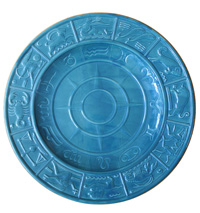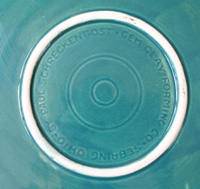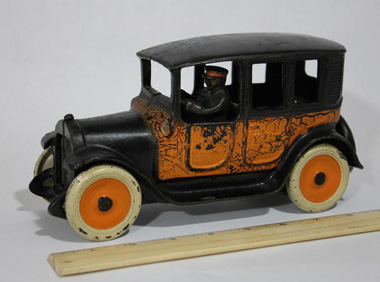 |
|
|||
 |
 |
|||
Copyright © Harry Rinker, LLC 2013
Questions
and Answers
ANSWER: I only found scattered references to Paul Schreckengost (1908-1983) on the internet as well. The Wikipedia reference for Viktor Schreckengost notes: “His younger brothers Donald and Paul Schreckengost also went on to careers as ceramicists.” [For more information, see: http://en.wikipedia.org/wiki/Viktor_Schreckengost ] Donald worked at Homer Laughlin and Hall China I found sale records for a Paul Schreckengost teapot from a tea service and a punch service on artnet.com. [ http://www.artnet.com/artists/paul-schreckengost/past-auction-results ] Liveauctioneers.com lists an example of the teapot that sold for $5,000.00 plus a buyer’s penalty at Wright in Chicago on December 13, 2012. The description notes: “Paul Schreckengost, Viktor’s younger brother, is…known for his streamlined designs.” The two references cited are American Streamlined Design: The World of Tomorrow (Hans and Hoy / page 18) and Les Annéss 30 (Bony / page 1029). [http://www.liveauctioneers.com/item/14531508_paul-schreckengost-teapot] In an attempt to learn more about Paul Schrenckgost, I called Phil Ricard at the Museum of Ceramics in East Liverpool, Ohio. He informed me that he did not have a file on Paul Schreckengost and suggested I contact the Sebring Ohio Historical Society. Before I found time to do this, I received an email from Paul’s son Paul R. Schreckengost, who lives in Indian Wells, California. Ricard had forwarded my request. Paul and his wife Delaine provided me with the following information: Paul Gruber Schreckengost was born on January 1, 1908, at the family home of Warren and Adda Schrenkengost located at 222 W. Indiana Avenue, Sebring, Ohio. The house was built in 1902 and is owned and restored by Paul Richard Schreckengost. Paul Gruber Schreckengost was one of nine children—six boys and three girls. Three of the boys died. Viktor (1906), Paul, Don (1910) and the three girls Pearl, Ruth, and Lucille survived. All the children showed art talent at an early age. The six graduated from Sebring High School. Viktor, Paul, and Don went on to study at the Cleveland Institute of Art. Paul Gruber Schreckengost was employed by the Gem Clay Forming Company. Within a short period of time, he became the company’s chief designer and mold maker. He retired from Gem Clay Forming Company in 1976. In the mid-1930s, a studio was built behind the Schreckengost home on Indiana Avenue. Paul worked there at night and on weekends. Viktor and Don often joined him. Paul Gruber Schreckengost met Doris Evelyn (Betty) Frye in 1940 while visiting the Sebring Recreation Bowling Alley owned by Betty’s father Homer. Paul and Betty were married and had eight children. In 1947, Paul and Betty purchased a home at 345 West Ohio Avenue in Sebring. The basement was converted into an art studio. Paul was athletically inclined and always found time in his busy schedule for family activities. Paul Gruber Schreckengost designed thousands of items, including busts, coffee mugs, cookie jars, dinnerware, figurines, lamps, salt and pepper sets, statues, and teapots. In 1935, the Treasury Department asked him to design the Jefferson nickel which features Monticello on the reverse. His famous tea and punch sets date from 1936. Gem Clay made 66 sets as Christmas gifts for customers and employees. The Zodiac plate, made in 10in and 14in diameter, was created in 1940. The plate came in a variety of colors. Blue and brown are the most common. Paul Schreckengost’s Running Black Panther, available in three sizes (the largest 21in in length), is a 1950s iconic figural form. An example graces a coffee table at Elvis’ Graceland Mansion in Memphis.
Gem Clay’s “Our Gang” and Tarzan clay figures are eagerly sought by collectors. Donald, Paul, and Victor Schreckengost are credited with creating the sculptures and molds for the Tarzan set. The hollow cast Tarzan figures were cast in a white bisque and sold as a set along with instructions on how to paint them. In November 2012, Hake’s Americana and Collectibles sold a set of 12 Tarzan figures for $1,706.81, which includes the 15% buyer’s penalty. [http://www.hakes.com/item.asp?Auction=207&ItemNo=117485; also see http://www.rodneysdimestoregallery.com/gem_clay_forming_co_ ] [Author’s Aside #1: Although this may seem to some as information overload, it is not. As a person who uses the internet heavily for research purposes, I realize that information is scattered and often unavailable. When I am presented with the opportunity to provide new information or condense tidbits of information into one location, I do it.] Values for a Paul Schreckengost Zodica plate vary. With persistence, a collector can find a blue or brown example between $150.00 and $200.00. There are sellers who ask double these amounts. Harder to find colors command more.
QUESTION: After collecting Tootsietoy Grahams, I graduated to cast iron toys, especially Arcade. I recently bought a 9in, No. 1 Arcade taxi with the embossed “Yellow Cab” on the doors for $230.00. What advice do you have for me? – JG, Swarthmore, PA, Email Question ANSWER: Like so many collecting categories whose objects dates primarily from the 1920s through the 1940s, the secondary cast iron toy market is in transition. First, the generation who played with these toys is dead or near death. The hand-me down generation who also played with them and collected them is in their late seventies and early eighties. Toy collectors under 50 have little to no interest in cast iron toys. Second, many of the major cast iron toy collections will flow into the secondary market over the next 10 to 15 years. Unless some control is exercised by the leading toy auctioneers, the market will flood, even at the high end. Further, the auctioneers who sell cast iron and other pre-1945 toys are aging. Their survival is questionable. Third, the lack of new collectors has caused the low and middle end of the market to fall on extremely hard times. Value can be reduced as much as 75 percent from the highs of the 1980s marketplace. While interest remains strong in the high end of the market (masterpiece/ultimate units and upper echelon pieces) at the moment, there is no guarantee this will continue. Fourth, condition is everything. Avoid examples that grade below very fine. If you can see any damage at arm’s length, do not buy the piece. If there is any paint loss, do not buy. If the paint color is faded, think twice. It is better to buy one piece in very fine or better condition than to buy multiple pieces in good to very good condition. [Author’s Aside #2 : My head tells me to recommend that you do not buy any pieces in less than excellent condition (C8 or higher). Having had the privilege of seeing dozens of cast iron toy collections during my career, these pieces are available. Do not make the mistake of assigning more scarcity to a piece than required or fall victim to the “I will buy a lesser piece until I find a better piece” mentality. When you find a better piece, you will not be able to sell your lesser piece for what you paid nor will you find anyone willing to trade up.] Fifth, focus on one single company or vehicle form. This is not the time to assemble a type collection. Long-term strength rests in meaningful numbers. Collection size is not one of them. Objects from one company are. Sixth, understand the risk involved. This is not a market that will witness a significant rise in value. Sellers that claim a market renaissance will occur do not know about what they are talking. Cast iron toys are an endangered collecting category. If you are collecting cast iron toys because you love them, enjoy them, and want to learn more about them, move forward. If you think of them as your retirement fund, invest in something else.Harry L. Rinker welcomes questions from readers about
collectibles, those mass-produced items from the twentieth and twenty-first centuries.
Selected letters will be answered in this column.
Harry cannot provide personal answers.
Photos and other material submitted cannot be
returned.
Send your questions to: Rinker on Collectibles, 5955 Mill
Point Court SE, Kentwood, MI 49512.
You also can e-mail your questions to
harrylrinker@aol.com.
Only e-mails containing a full name and mailing address
will be considered.
You can listen
and participate in
WHATCHA GOT?, Harry’s
antiques and collectibles radio call-in show, on Sunday mornings between 8:00 AM
and 10:00 AM Eastern Time.
If you
cannot find it on a station in your area,
WHATCHA GOT?
streams live on the Internet at www.gcnlive.com.
SELL, KEEP OR TOSS?: HOW TO DOWNSIZE A HOME,
SETTLE AN ESTATE, AND APPRAISE PERSONAL PROPERTY
(House of Collectibles, an imprint of Random House Information Group, $17.99),
Harry’s latest book, is available at your favorite bookstore and via
www.harryrinker.com.
|
||||
 QUESTION: I have a 9in. diameter, sky blue, Zodiac-theme plate designed by Paul Schreckengost for Gem Clay Forming Company of Sebring, Ohio. Viktor Schreckengost, a famous designer and longtime professor at the Cleveland Institute of Art, was Paul’s brother. I found a great deal of information about him but very little about Paul on the internet. What information can you provide? – BM from OH, Email Question
QUESTION: I have a 9in. diameter, sky blue, Zodiac-theme plate designed by Paul Schreckengost for Gem Clay Forming Company of Sebring, Ohio. Viktor Schreckengost, a famous designer and longtime professor at the Cleveland Institute of Art, was Paul’s brother. I found a great deal of information about him but very little about Paul on the internet. What information can you provide? – BM from OH, Email Question The Gem Clay Forming Company was created from the merger of three small garage potteries – E. C. Albright, B. H. Green, and H. D. Weaver. The company’s original location is in dispute – one source claiming Bellaire in Belmont County and a second East Liverpool, Ohio. However, by the early 1900s, the pottery operated from plant at West Georgia Avenue and Railroad Street in Sebring and remained there until the mid-1980s. The plant burned in 1908 and was rebuilt. Heating and electrical porcelain and refractory ware were the company’s primary products. Children’s clay figurines, baby dishes, household accessories and decorative items, lamp bases, and salt and pepper shakers were added to the line.
The Gem Clay Forming Company was created from the merger of three small garage potteries – E. C. Albright, B. H. Green, and H. D. Weaver. The company’s original location is in dispute – one source claiming Bellaire in Belmont County and a second East Liverpool, Ohio. However, by the early 1900s, the pottery operated from plant at West Georgia Avenue and Railroad Street in Sebring and remained there until the mid-1980s. The plant burned in 1908 and was rebuilt. Heating and electrical porcelain and refractory ware were the company’s primary products. Children’s clay figurines, baby dishes, household accessories and decorative items, lamp bases, and salt and pepper shakers were added to the line.